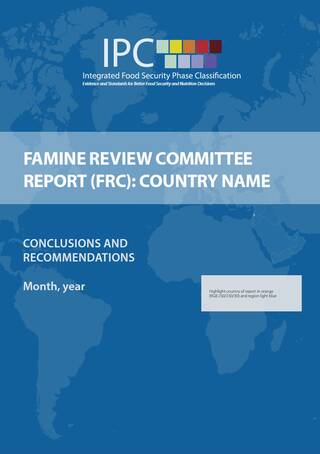FRC Report

Type and Objective of Product
Technical Analysis Product
The FRC Report is a document that presents the conclusions of the Famine Review Committee after assessing the technical soundness of additional related documents, which may be published alongside the report upon request. The IPC report provides conclusions on the plausibility of famine classification, along with recommendations for senior decision-makers, Resource Partners, and the Humanitarian Country Team, as well as guidance on data collection and analysis.
Ownership
This report is produced by the FRC, an independent technical body that reviews and validates famine classifications in conjunction with the IPC GSU based on available data and may also be jointly developed with the IPC TWG. The GSU oversees the development and finalization process, ensuring consistency and credibility, while the findings and content are owned by the FRC and GSU.
Mandatory Content
Each FRC Report includes the following key components:
- Executive Summary: A brief outline of key findings and conclusions.
- Famine Review Process: The methodology and approach used in the FRC assessment.
- FRC Assessment of the Situation: FRC Analysis of current food security conditions.
- Conclusions for the Current Period: Findings on famine status and contributing factors.
- Conclusions for the Projection Period: Expected trends and future risks.
- Recommendations: Suggested actions for response and mitigation.
- Annexes: Supporting data and additional information.
Target Audience
The FRC Report is designed to meet the needs of a diverse range of technical audiences, including:
- Donors (Primary): International donors providing critical funding and resources for humanitarian efforts.
- Media and Advocacy Groups (Primary): Organisations disseminating findings to raise public awareness.
- Humanitarian Agencies: UN agencies, NGOs, and donors are involved in planning and implementing interventions.
- Government Authorities: National and regional authorities.
- Policy Makers: Officials tasked with resource allocation, strategic planning, and policy.
Branding and Format
The FRC Report follows standardised branding to ensure consistency and credibility:
- Size: Standard A4 Book format.
- IPC Logo and Colour Scheme: The report features the signature IPC Blue (CMYK 94 63 13 1, RGB 1 97 156, Web Hex #01619c) with the IPC logo strip at the top.
- Funding partner Logos: All FRC report should bare IPC funding partner logos on the acknowledgments page.
- Fonts: The primary and secondary font is Myriad Pro, a sans-serif typeface with a classic and fresh appearance that aligns with the IPC brand.
- Pagination: FRC reports must be between 25 and 45 pages, including annexes.
Log Information and Disclaimers
- Mandatory Log Information: Publication date
- FRC Member’s names and titles.
- Product Description: It is essential to include the product description as follows: In this report, the Famine Review Committee (FRC) presents its analysis and conclusions on the current and projected classifications for the XXX. The FRC has thoroughly reviewed the TWG analysis, along with additional data, and provides a plausibility assessment of these findings.
Dissemination
FRC Reports are distributed through multiple channels to maximise reach and impact, including:
- The IPC website.
- Email blasts targeting key stakeholders, especially for the Top Ten Crises.
- Social media platforms such as X (formerly Twitter) and Linkedin.
This multi-channel dissemination strategy ensures that IPC reports are accessible to diverse audiences, including policymakers, humanitarian organisations, and the public.